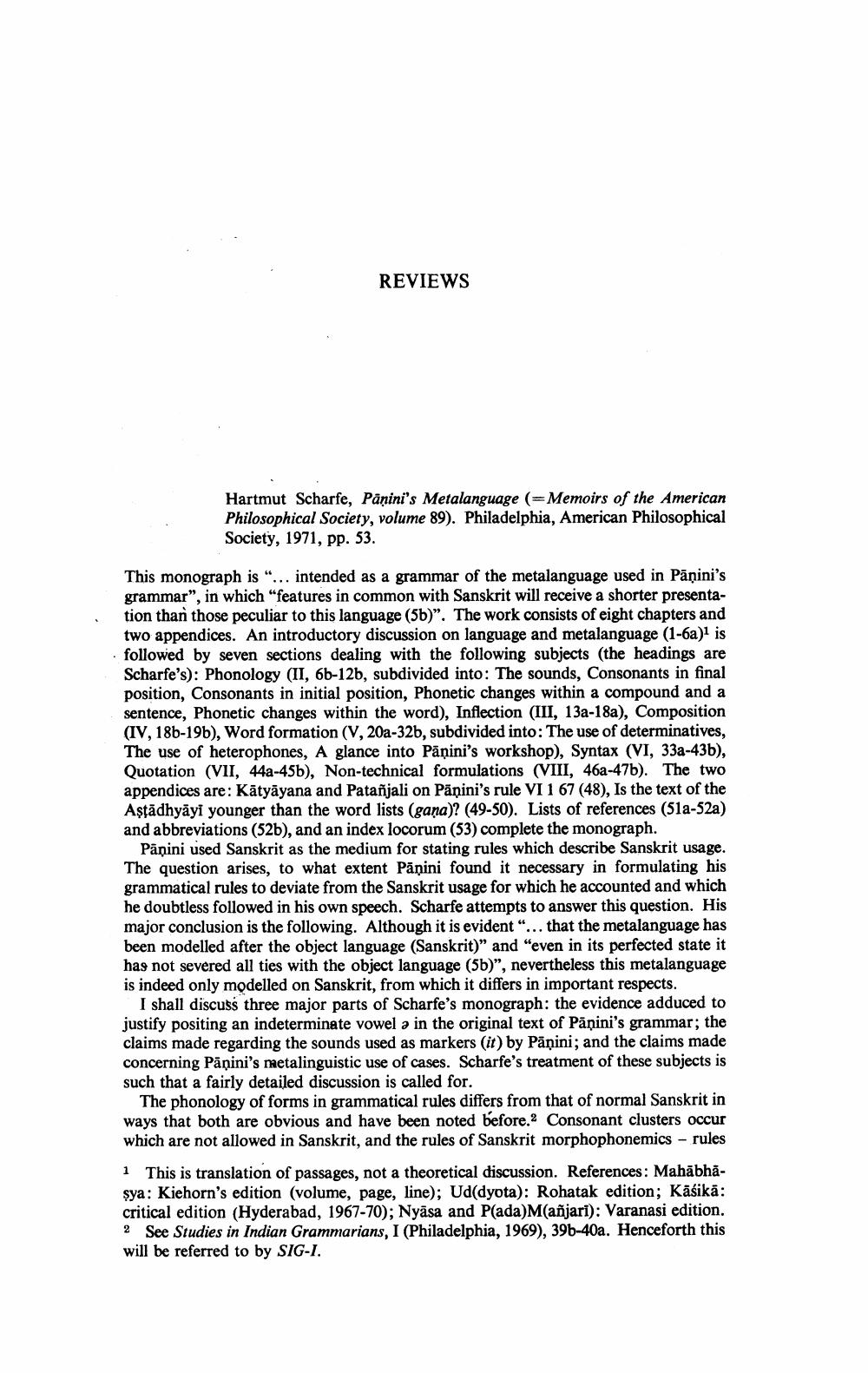Book Title: Reviews Of Different Books Author(s): Publisher: View full book textPage 1
________________ REVIEWS Hartmut Scharfe, Panini's Metalanguage (=Memoirs of the American Philosophical Society, volume 89). Philadelphia, American Philosophical Society, 1971, pp. 53. This monograph is "... intended as a grammar of the metalanguage used in Panini's grammar", in which "features in common with Sanskrit will receive a shorter presentation than those peculiar to this language (5b)". The work consists of eight chapters and two appendices. An introductory discussion on language and metalanguage (1-6a)1 is followed by seven sections dealing with the following subjects (the headings are Scharfe's): Phonology (II, 6b-12b, subdivided into: The sounds, Consonants in final position, Consonants in initial position, Phonetic changes within a compound and a sentence, Phonetic changes within the word), Inflection (III, 13a-18a), Composition (IV, 186-19b), Word formation (V, 20a-32b, subdivided into: The use of determinatives, The use of heterophones, A glance into Panini's workshop), Syntax (VI, 33a-43b), Quotation (VII, 44a-45b), Non-technical formulations (VIII, 46a-47b). The two appendices are: Katyayana and Patanjali on Panini's rule VI 1 67 (48), Is the text of the Astadhyayi younger than the word lists (gana)? (49-50). Lists of references (51a-52a) and abbreviations (52b), and an index locorum (53) complete the monograph. Panini used Sanskrit as the medium for stating rules which describe Sanskrit usage. The question arises, to what extent Panini found it necessary in formulating his grammatical rules to deviate from the Sanskrit usage for which he accounted and which he doubtless followed in his own speech. Scharfe attempts to answer this question. His major conclusion is the following. Although it is evident"... that the metalanguage has been modelled after the object language (Sanskrit)" and "even in its perfected state it has not severed all ties with the object language (56)", nevertheless this metalanguage is indeed only modelled on Sanskrit, from which it differs in important respects. I shall discuss three major parts of Scharfe's monograph: the evidence adduced to justify positing an indeterminate vowel a in the original text of Panini's grammar; the claims made regarding the sounds used as markers (it) by Panini; and the claims made concerning Panini's metalinguistic use of cases. Scharfe's treatment of these subjects is such that a fairly detailed discussion is called for. The phonology of forms in grammatical rules differs from that of normal Sanskrit in ways that both are obvious and have been noted before.2 Consonant clusters occur which are not allowed in Sanskrit, and the rules of Sanskrit morphophonemics - rules 1 This is translation of passages, not a theoretical discussion. References: Mahabhasya: Kiehorn's edition (volume, page, line); Ud(dyota): Rohatak edition; Kasika: critical edition (Hyderabad, 1967-70); Nyasa and P(ada)Manjari): Varanasi edition. 2 See Studies in Indian Grammarians, I (Philadelphia, 1969), 39b-40a. Henceforth this will be referred to by SIG-I.Page Navigation
1 2 3 4 5 6 7 8 9 10 11 12 ... 33
